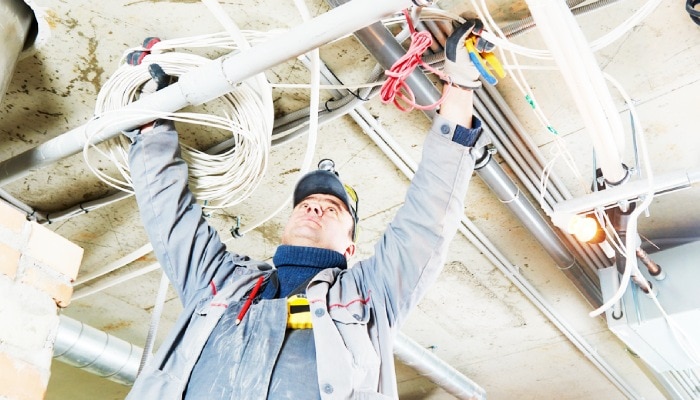High-rise buildings epitomize modern challenges and innovations, especially within their plumbing systems. These towering structures demand more than just the basic provision of water; they require sophisticated engineering to tackle issues like ensuring adequate water pressure across numerous floors and efficient storm water drainage. Unlike low-rise structures, high-rise buildings face external factors such as gravity challenges and heightened environmental concerns, necessitating a careful balance between supply and waste management to meet the needs of residents and businesses while maintaining safety measures.
Understanding the unique demands placed on high-rise plumbing systems begins with an exploration of the issues they face. From the gravity challenge affecting water supply and drainage to the importance of sustainable design and safety measures, each aspect of plumbing in these vertical cities requires a thoughtful and innovative approach. This section introduces the multifaceted world of high-rise plumbing, setting the stage for a closer look at the solutions crafted to navigate these unique challenges most successfully.

Understanding the Gravity Challenge: Water Supply and Distribution
The core of the gravity challenge in high-rise buildings lies in ensuring that water reaches every floor with sufficient pressure. Gravity naturally pulls water downwards, making it easier to supply lower floors but increasingly difficult to push water to the heights of a skyscraper. This necessitates the use of booster pumps, strategically placed within the building to elevate water pressure and distribute it evenly across all levels. These pumps are the heart of a high-rise’s water supply system, ensuring that every tap, shower, and appliance receives water at the right pressure.
However, simply pumping water to the top is not enough. The system must be carefully calibrated to prevent excessive pressure on lower floors, which could lead to leaks or damage to critical systems. This is where pressure-reducing valves come into play. Installed at various points within the plumbing network, these valves ensure that the water pressure is regulated, providing a consistent flow rate that is both safe and efficient for the entire building.
The complexity of these systems is further increased by building codes and the need to accommodate fluctuations in demand throughout the day and across different seasons. Engineers must design water supply systems that are not only robust but also flexible, capable of adapting to the variable usage patterns of residents and businesses within the building. Advanced monitoring and control technologies play a crucial role here, allowing for real-time adjustments to pump operations and pressure settings to optimize performance and efficiency.
Additionally, the water distribution network within a high-rise must be meticulously designed to prevent contamination and ensure water quality. This involves the strategic placement of pipes, the selection of materials resistant to corrosion and biofilm formation, and the incorporation of filtration and treatment solutions as necessary. Collaboration among various professionals, including structural engineers for accommodating the weight of plumbing infrastructure, air conditioning units for temperature control, and vertical transportation systems for facilitating installation and maintenance, is paramount in ensuring seamless integration within high-rise structures. These interdisciplinary efforts contribute to the overall success and functionality of plumbing systems in high-rise apartments and commercial structures.
Wastewater Management: Drainage and Venting Solutions
Wastewater management in high-rise buildings encompasses more than just efficiently channeling water away from the property; it involves sophisticated systems designed to handle the volume of waste and stormwater while preventing backflow and ensuring the health of the building’s plumbing. The challenges are amplified by the structure’s height, which can complicate the gravity-driven flow of wastewater.
To address these issues, high-rise buildings employ a combination of gravity-fed and mechanical systems to ensure effective drainage. One key component is the use of larger-diameter pipes for main drainage lines, which helps in accommodating the volume of wastewater without requiring steep gradients. These pipes are carefully sloped to maintain a self-cleansing velocity, preventing blockages that could lead to backups or overflows.
Another critical aspect of wastewater management is the integration of venting systems. Vent pipes are essential for preventing a vacuum from forming in the drainage system, which can slow down water flow or, worse, suck water out of traps, leading to flooding and the release of sewer gases into living spaces. Proper venting ensures that each fixture maintains an air balance, facilitating the smooth flow of wastewater to the sewer lines.
Innovative solutions like siphonic roof drainage systems can also be found in high-rise buildings. Unlike traditional systems that rely on gravity and require a sloped roof for water to flow towards drains, siphonic systems use a combination of carefully designed pipework and negative pressure to draw water from the roof at a faster rate. This technology not only enhances drainage efficiency during heavy rainfall but also reduces the piping diameter needed, saving space and materials.
Moreover, the integration of advanced wastewater treatment technologies within the building can further enhance sustainability. Greywater recycling systems, for example, treat and reuse water from showers, sinks, and laundry for non-potable applications like toilet flushing and landscape irrigation, significantly reducing the building’s overall water consumption.

Hot Water Systems: Ensuring Consistency and Efficiency
The delivery of hot water in high-rise buildings is a critical aspect that demands careful planning and design to ensure both consistency and efficiency. The challenges are multifaceted, involving the need to supply hot water at a consistent temperature to all residents, minimizing heat loss, and ensuring energy efficiency across many floors. This section delves into the various systems and technologies that address these challenges.
Centralized vs. Decentralized Systems
One major consideration is the choice between centralized and decentralized hot water systems. Centralized systems, where hot water is generated in a single location and distributed throughout the building, are advantageous for their efficiency at scale and easier maintenance. However, they can suffer from significant heat loss during transit, especially in very tall buildings, unless the distribution system is meticulously insulated.
Decentralized systems, on the other hand, employ multiple smaller heaters located closer to points of use. This setup can significantly reduce transit time and heat loss, providing faster access to hot water and improving energy efficiency. The trade-off includes higher upfront costs and the need for space within each unit to accommodate the heating units.
Renewable Energy Integration
The integration of renewable energy sources, such as solar thermal panels or heat pumps, into the building’s hot water system can substantially reduce the environmental footprint and operational costs. Solar thermal systems, for example, can preheat water to reduce the load on traditional heating systems, while heat pumps can efficiently transfer heat from the air or ground into the water. These technologies not only contribute to a building’s sustainability goals but also can offer long-term cost savings.
Advanced Technologies for Temperature and Efficiency Control
To further enhance efficiency and user satisfaction, high-rise buildings are increasingly incorporating advanced technologies for temperature control and energy conservation. Automated control systems can adjust water temperature and flow based on real-time demand, reducing waste and ensuring that hot water is always available when needed. Additionally, smart insulation materials and techniques can minimize heat loss in water storage tanks and distribution pipes, maintaining water temperature more effectively.
Overcoming Noise and Vibration Issues in Plumbing Systems
The intricate plumbing systems of high-rise buildings not only need to efficiently manage water supply and waste but also minimize noise and vibration, which can significantly impact resident comfort. As water moves through pipes, operates valves, or is pumped to higher floors, it can generate noise and vibrations that, if not properly addressed, resonate throughout the structure. This section explores the strategies and materials used to mitigate these concerns, ensuring a quiet and peaceful living environment.
Sound Insulation and Pipe Placement
A primary strategy in combating plumbing noise is the strategic placement of pipes combined with sound insulation. Pipes are ideally positioned within interior walls and away from quiet areas such as bedrooms and living rooms to minimize disturbance. Moreover, using insulating materials around pipes can absorb sound, reducing the transmission of noise through walls and floors. Insulation not only serves thermal purposes but also plays a critical role in sound dampening.
Anti-vibration Mounts and Supports
To address high rise building vibrations, especially those caused by high-capacity pumps and machinery, the installation of anti-vibration mounts and supports is crucial. These devices are designed to absorb and isolate vibrations, preventing them from spreading through the building’s structure. The selection of these mounts is based on the weight and operational characteristics of the equipment, ensuring effective vibration reduction.
Pipe Material and Diameter Selection
The material and diameter of pipes also significantly influence noise levels. For instance, cast iron and certain types of plastic pipes have inherently good sound-dampening properties compared to other materials. Larger-diameter pipes can reduce water velocity, thereby lowering noise associated with high-speed water flow. The choice of pipe material and size is a critical consideration in the design phase to balance cost, efficiency, and noise reduction.
Innovative Technologies and Designs
Emerging technologies and design innovations offer new ways to tackle noise and vibration in plumbing systems. For example, silent check valves are designed to close quietly, reducing the banging noise commonly associated with traditional valves. Similarly, the implementation of more sophisticated water hammer arrestors can absorb sudden pressure changes within pipes, preventing the loud banging noises that can occur when valves close rapidly.

Case Studies: Success Stories of Overcoming Plumbing Challenges
This section showcases real-world examples of high-rise buildings that have effectively addressed complex plumbing challenges. Through innovative engineering and thoughtful design, these buildings demonstrate how to make plumbing issues ensure efficiency, sustainability, and resident comfort in urban skyscrapers.
Efficient Water Supply and Distribution
One high-rise utilized a dual-pump system equipped with variable speed drives, which allowed for adaptive control over water pressure, ensuring that water reached the upper floors without overwhelming the lower levels. This building also embraced a decentralized hot water system, reducing energy consumption by integrating solar thermal technology to preheat water. This approach to building management not only provided consistent hot water to all residents but also set a standard for energy-efficient water management in tall structures.
Advanced Wastewater Management
Another notable example is a building that installed a comprehensive greywater recycling system. This system treated water from baths, sinks, and laundry, repurposing it for toilet flushing and landscape irrigation. By doing so, the building significantly reduced its fresh water demand. Additionally, it adopted a siphonic drainage system that efficiently managed heavy rainfall without compromising the structural integrity of the roof or the comfort of the residents, showcasing an innovative approach to stormwater management.
Mitigating Noise and Vibration
Addressing the common issue of noise and vibration from plumbing systems, a particular high-rise focused on using materials and designs that dampen sound. Cast iron pipes were chosen for their sound-reducing qualities, and mechanical equipment was mounted on anti-vibration supports to minimize the transmission of vibrations. Strategic placement of plumbing shafts away from critical living areas further ensured that residents enjoyed a peaceful environment. This building stands as a prime example of how material selection and design considerations can significantly impact the acoustic comfort in high-rise living spaces.
These case studies illustrate the possibilities when confronting the plumbing challenges inherent in high-rise construction. By leveraging innovative solutions and prioritizing both sustainability and occupant comfort, these buildings highlight the successful integration of technology and design in modern urban development. Each story provides valuable lessons for future projects, emphasizing that with creativity and engineering excellence, even the most daunting obstacles can be overcome.

Conclusion
In navigating the complexities of plumbing in high-rise buildings, innovation emerges as the cornerstone of success. Through creative engineering and strategic design, challenges such as water supply, wastewater management, and noise reduction are effectively addressed. These case studies serve as beacons of inspiration, guiding future projects towards greater efficiency, sustainability, and resident satisfaction. As urban landscapes evolve, so too must our approach to plumbing, ensuring that high-rise buildings not only rise to new heights but also set new standards for functionality, safety regulations and comfort.



